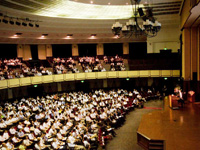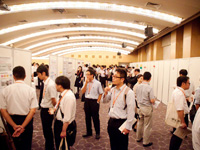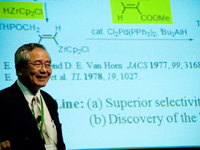
Keynote Lecture

Poster Session

Keynote Lecture by Prof. Negishi
The International Conference on Flexible and Printed Electronics (ICFPE2012) was held at the Hongo Campus of the University of Tokyo from September 6 to 8, 2012 with 1,149 researchers and students from Japan and abroad in attendance; of all the participants, overseas researchers accounted for 27℅. This international conference consisted of five keynote speeches, 30 technical sessions including 434 oral and poster presentations and 32 corporate exhibits. The research supervisor of ERATO Someya Bio-Harmonized Electronics Project, Professor Takao Someya, School of Engineering of the University of Tokyo, served as the head of the organizing committee and introduced the outline of the project study.
ICFPE2012 was intended to promote more progress in the relevant technological fields, which are strongly interdisciplinary, by providing an occasion for a meeting of active researchers engaged in printed electronics as well as flexible electronics fields from Japan and abroad. The conference included participants extensively engaged in academic fields and largely industrial technologies in terms of materials, processes/equipment, devices, and circuit/systems/mounting and evaluation. At each technical session and presentation, such as a poster session, the participants had very enthusiastic discussions.
Eiichi Negishi, the 2010 Nobel laureate in chemistry and distinguished professor at Purdue University, delivered the keynote lecture on catalytic reactions for organic synthesis. Dr. Kinam Kim from Samsung Advanced Institute of Technology and Dr. Ryoji Chubachi from SONY briefed the audience on corporate strategies and expectations in the flexible printed electronics field. Prof. Michael Graetzel of EPFL in Switzerland lectured on dye-sensitized solar cells, and Prof. John A. Rogers from the University of Illinois in the US spoke on the latest research results and possible development of applications of new flexible devices.
Technical sessions had presentations by 197 researchers, of which 113 researchers were from abroad. Of those 197 researchers, 66 invited speakers, which included 44 researchers from abroad, presented the latest research results and future outlook in such subjects as new organic thin films, new printing technology, and how to evaluate devices. These presentations aroused very lively exchanges of views among different fields. The Digital Fabrication for Flexible and Printed Electronics session had discussions of organic electronics device production technology with the most up-to-date printing method, which is the exact research subject of ERATO Someya Bio-Harmonized Electronics Project. Its group leader, Tsuyoshi Sekitani, introduced a large-area, super-flexible sensor device fabricated by printing technology. This particular session attracted so many researchers that the venue could not accommodate everyone. Participants asked many questions on possible applications in the biomedical field. These sessions served as an opportunity for meaningful exchanges of technical views.
Reports of each session will be released on the official website at http://www.icfpe.jp.
This international conference provided not only lectures by leading researchers working in flexible electronics devices and printed electronics fields but also many valuable comments in promoting the ERATO Someya Bio-Harmonized Electronics Project through active discussions at each section.
JST, an integrated organization of science and technology in Japan, establishes an infrastructure for the entire process from the creation of knowledge to the return to the society. For more information, visit http://www.jst.go.jp/EN/